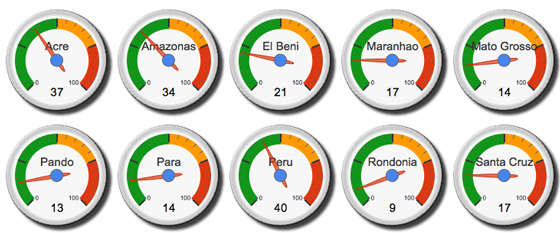News | May 15, 2012
Mild fire forecast
By Kathryn Hansen and Janet Wilson,
NASA's Goddard Space Flight Center and University of California, Irvine
Forests in the Amazon Basin are expected to be less vulnerable to wildfires this year, according to the first forecast from a new fire severity model developed by university and NASA researchers.
Fire season across most of the Amazon rain forest typically begins in May, peaks in September and ends in January. The new model, which forecasts the fire season’s severity from three to nine months in advance, calls for an average or below-average fire season this year within 10 regions spanning three countries: Bolivia, Brazil and Peru.
“Tests of the model suggested that predictions should be possible before fire activity begins in earnest,” said Doug Morton, a co-investigator on the project at NASA’s Goddard Space Flight Center in Greenbelt, Md. “This is the first year to stand behind the model and make an experimental forecast, taking a step from the scientific arena to share this information with forest managers, policy makers, and the public alike.”

The model was first described last year in the journal Science. Comparing nine years of fire data from NASA’s Moderate Resolution Imaging Spectroradiometer (MODIS) on the Terra satellite, with a record of sea surface temperatures from NOAA, scientists established a connection between sea surface temperatures in the Pacific and Atlantic oceans and fire activity in South America.
“There will be fires in the Amazon Basin, but our model predictions suggest that they won’t be as likely in 2012 as in some previous years,” said Jim Randerson of the University of California, Irvine, and principal investigator on the research project.
Specifically, sea surface temperatures in the Central Pacific and North Atlantic are currently cooler than normal. Cool sea surface temperatures change patterns of atmospheric circulation and increase rainfall across the southern Amazon in the months leading up to the fire season.
“We believe the precipitation pattern during the end of the wet season is very important because this is when soils are replenished with water,” said Yang Chen of UC Irvine. “If sea surface temperatures are higher, there is reduced precipitation across most of the region, leaving soils with less water to start the dry season.”
Without sufficient water to be transported from the soil to the atmosphere by trees, humidity decreases and vegetation is more likely to burn. Such was the case in 2010, when above-average sea surface temperatures and drought led to a severe fire season. In 2011, conditions shifted and cooler sea surface temperatures and sufficient rainfall resulted in fewer fires, similar to the forecast for 2012.

Building on previous research, the researchers said there is potential to adapt and apply the model to other locations where large-scale climate conditions are a good indicator of the impending fire season, such as Indonesia and the United States.
Amazon forests, however, are particularly relevant because of their high biodiversity and vulnerability to fires. Amazon forests also store large amounts of carbon, and deforestation and wildfires release that carbon back to the atmosphere. Predictions of fire season severity may aid initiatives – such as the United Nation’s Reducing Emissions from Deforestation and forest Degradation program – to reduce the emissions of greenhouse gases from fires in tropical forests.
“The hope is that our experimental fire forecasting information will be useful to a broad range of communities to better understand the science, how these forests burn, and what predisposes forests to burning in some years and not others,” Morton said. “We now have the capability to make predictions, and the interest to share this information with groups who can factor it into their preparation for high fire seasons and management of the associated risks to forests and human health.”
To see the 2012 prediction and UC Irvine disclaimer clause, visit:
https://webfiles.uci.edu/ychen17/data/SAMFSS.html
Related story, "Ocean Temperatures Can Predict Amazon Fire Season Severity":
http://www.nasa.gov/mission_pages/fires/main/amazon-fire-season.html
